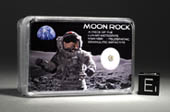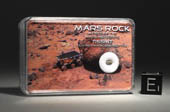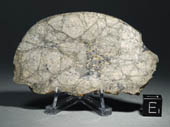

Visit our online store to get your piece of the Moon

Click here for valuable and impressive display pieces of Mars and Lunar meteorites

Information for resellers, click here

2012 , SR-Meteorites, All Rights Reserved
Mail to Webmaster. Imprint
How are Moon and Mars rocks transported to the Earth?
Countless ancient asteroids are circulating as rocky debris in the Solar System. Occasionally, a larger asteroid passes near or impacts another asteroid, or travels close enough to a planet to alter its path dramatically. Due to the absence of a thick atmosphere on Mars or the Moon, an appreciable impact on either can literally smash bedrocks off the surface of either Moon and Mars and send them flying into space. With little or no atmosphere to slow these ricocheting rocks, they can escape the lower gravity of both the Moon and Mars and create swarms of smaller ejected rocks circulating independently in the Inner Solar System. This includes a rare few that potentially can collide with Earth.
Countless ancient asteroids are circulating as rocky debris in the Solar System. Occasionally, a larger asteroid passes near or impacts another asteroid, or travels close enough to a planet to alter its path dramatically. Due to the absence of a thick atmosphere on Mars or the Moon, an appreciable impact on either can literally smash bedrocks off the surface of either Moon and Mars and send them flying into space. With little or no atmosphere to slow these ricocheting rocks, they can escape the lower gravity of both the Moon and Mars and create swarms of smaller ejected rocks circulating independently in the Inner Solar System. This includes a rare few that potentially can collide with Earth.
With extraordinary luck, an errant rock propelled in the right direction has the chance to impact the Earth as we orbit the Sun, much the same as the showers of shooting stars we see several times each year. This can happen after millions of years when the paths of earth and the rock just happen to line up for collision.
Meteorites of Lunar and Martian origin are among the most sought after and valuable meteorites to reach the Earth. Scientists classify then depending upon what type of Lunar or Martian bedrock from which they were ejected.
Collectors covet these pieces of Mars and the Moon to the point of valuing them much more than gold. So far, 76 Lunar meteorites, and 61 Martian meteorites, have been discovered. The different classes of Lunar meteorites include the extremely rare Lunar mare basalts and the impact breccias. Martian meteorites generally are called SNC meteorites. These are named after the location of the first fall of each different type of Martian meteorites. S is for Shergotty (India), N for Nakhla (Egypt), and C for Chassigny (France). This shorthand refers to each class of Martian meteorites, specifically, Shergottites, Nakhlites and Chassignites. The most frequently discovered type of Mars meteorites is the Shergottite. About 90% of all Martian meteorites are from the Shergottite group. The Shergottites are further classified into three subgroups which are: Basaltic Shergottites, Poikilitic Shergottites, and Olivine Phyric Shergottites.
Collectors covet these pieces of Mars and the Moon to the point of valuing them much more than gold. So far, 76 Lunar meteorites, and 61 Martian meteorites, have been discovered. The different classes of Lunar meteorites include the extremely rare Lunar mare basalts and the impact breccias. Martian meteorites generally are called SNC meteorites. These are named after the location of the first fall of each different type of Martian meteorites. S is for Shergotty (India), N for Nakhla (Egypt), and C for Chassigny (France). This shorthand refers to each class of Martian meteorites, specifically, Shergottites, Nakhlites and Chassignites. The most frequently discovered type of Mars meteorites is the Shergottite. About 90% of all Martian meteorites are from the Shergottite group. The Shergottites are further classified into three subgroups which are: Basaltic Shergottites, Poikilitic Shergottites, and Olivine Phyric Shergottites.
